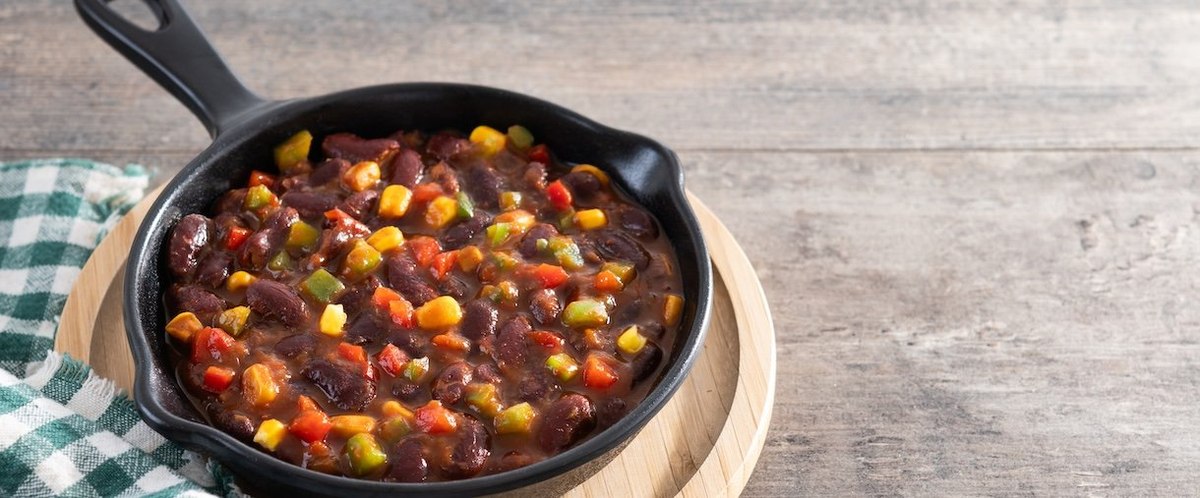Nixon and Khrushchev don't have a monopoly on kitchen debates: Plenty of food controversies divide the American public. Is a hot dog a sandwich? Does pineapple belong on pizza? Should you wash rice before cooking it? We can't give you the definitive answers, but we can tell you what Americans think. In a recent YouGov poll, we posed these questions and others — a dozen in all. Some popular food controversies divide Americans, while others have a clear majority pick. Are you in with the popular food crowd, or do your opinions buck conventions? Read on to find out!
Is it getting chili in here?
A clip from Denver's Next on 9 News recently went viral after anchors debated whether chili can be your favorite soup. The newsroom was divided between staffers holding the view that chili was an acceptable soup, and others who say it is instead a stew. What do the American people have to say?
A majority (60%) of Americans say that chili is a stew. Only 18% say it is a soup, less than the 23% who say it is neither a soup nor a stew. About one-third (32%) of Midwesterners say that chili is a soup. That's less than the 49% of Midwesterners who say it's a stew, but it's more than double the share who say soup in any other region (13% in the Northeast, 15% in the South, and 11% in the West).
Whether you think chili is a soup or a stew, it's certainly a versatile dish prefix. You can have chili fries, chili pasta, chili dogs. Which reminds me of another debate...
What makes a sandwich a sandwich?
Is a hot dog a sandwich? It's a question that has divided Americans for years, with such luminaries as Supreme Court Justice Ruth Bader Ginsburg, the Merriam-Webster dictionary, and hot-dog-eating champions Joey Chestnut and Takeru Kobayashi publicly taking sides. Ginsburg and Merriam-Webster have said a hot dog is a sandwich, while Chestnut and Kobayashi have said it is not. But what does the public think?
A majority of Americans trust the experts — the hot dog eating champions, not the legal and lexicological authorities: 53% of Americans say a hot dog is not a sandwich, while 40% say it is. There's a generational divide on this question: While a majority (57%) of adults under 65 say a hot dog is not a sandwich and only 35% say it is, a majority of Americans 65 and older (54%) say it is and only 42% say it isn't.
Majorities in the country's Northeast, Midwest, South, and West all say that hot dogs are not sandwiches. But Northeasterners are more united on this question than are Americans in other regions: 59% of Northeasterners say that hot dogs are not sandwiches while only 33% say they are. So it may be safe to ask for a sandwich when ordering a Chicago-style hot dog or a Dodger Dog, but you may want to avoid it at a Sabrett cart.
What about the country's other most iconic fast food? While Americans are divided on the hot dog's status, most can agree that a hamburger is a sandwich. About three-quarters (73%) say that a hamburger is a sandwich, while only 23% say it is not. While majorities in all regions say that a hamburger is a sandwich, Americans in the Midwest (81%) and South (77%) are more united on this point than are those in the Northeast (62%) and West (68%). With Northeasterners more likely than those in other regions to reject the sandwich status of both hamburgers and hot dogs, it seems that the Northeast has the most exclusive definition of a sandwich.
No matter which way you slice it
To many Americans, it does matter which way you slice a sandwich. Regardless of what counts as a sandwich, most Americans have an opinion on whether it's better to cut it straight up and down or on a diagonal. About half (49%) of Americans prefer their sandwiches to be cut diagonally, while 29% prefer them to be cut vertically. The remaining 22% say they don't prefer either option.
Younger adults express the strongest preference for diagonal sandwiches: A majority (54%) of adults under 30 prefer their sandwiches cut in triangles, compared to just 29% who prefer vertical cuts. But diagonal cuts are more popular than vertical cuts in all age groups.
As with views on the definitional boundaries of sandwiches, Northeasterners are more opinionated than Americans in other regions about sandwich slicing. Only 9% of Northeasterners say they don't have a preference between vertical and diagonal cuts, compared to at least 21% in each of the other three regions. But in all regions, more residents prefer diagonal cuts to vertical cuts.
Laying down the law on cole slaw
We've covered soup. We've covered sandwiches. Now we just need a salad to complete our café combo. How about cole slaw? While it may not be a Caesar or a Cobb, cole slaw is a mix of ingredients, including a leafy green and a dressing. So is cole slaw a salad? Most Americans say yes. Two-thirds (67%) of Americans say cole slaw is a salad, while only one-quarter (25%) say it is not.
Older Americans are particularly likely to say cole slaw is a salad: 77% of Americans 65 and older say so, while about two-thirds (65%) of younger adults agree. Westerners are more likely to say cole slaw is a salad than Americans in other regions: 74% in the West say cole slaw is a salad, compared to 69% in the Northeast, 65% in the Midwest, and 64% in the South.
So should a chili dog with a side of cole slaw count as a soup, salad, and sandwich combo? According to the 6% of Americans who take all three of those stances, yes it should.
Opinions are scrambled about ketchup on eggs
A majority of Americans (57%) say they dislike or hate ketchup on eggs. About one-third (32%) say they like or love it. Older Americans are more likely than younger adults to have a negative view: About two-thirds (68%) of Americans 65 and older dislike ketchup on eggs, compared to 47% of adults under 30, with 21% unsure. Americans between 30 and 44 are the major age group most likely to like or love ketchup on eggs (39%, compared to 52% who dislike it).
The Northeast stands out from the rest of the U.S. when it comes to ketchup on eggs. Majorities of Midwesterners (62%), Southerners (58%), and Westerners (58%) dislike ketchup on eggs. But Northeasterners are evenly split: 46% like ketchup on eggs and 46% dislike it.
Pineapple: disturbing the pizza?
Is there anything as American as (pine)apple (pizza) pie? Well, it's actually not so American at all. Pineapple on pizza originated with the invention of the "Hawaiian" pizza in Canada. There was a minor diplomatic scuffle between Canada and Iceland when the president of Iceland joked that pineapple on pizza should be banned. Which side do Americans sympathize with? Views are quite evenly divided. About half (48%) of Americans like or love pineapple on pizza, but a similar share (44%) dislike or hate it.
Opinions are quite stable across age groups: About 44% of adults in all age groups dislike pineapple on pizza. About 49% in all age groups like it, with the exception of adults under 30: Only 43% of 18- to 29-year-olds like pineapple on pizza. Adults under 30 are more likely than older Americans to say they're not sure about pineapple on pizza (14% vs. 6%).
As with many other food opinions, Northeasterners also stand out for their views about pineapple on pizza. A majority (59%) of Americans in the Northeast dislike pineapple on pizza. In all other regions, 42% dislike it, with larger shares saying they like it. Northeasterners live closer to the Hawaiian pizza's birthplace — Ontario, Canada — than most other Americans, so this may be a case where having a little more space helps you appreciate things.
Are Americans hot or cold on leftover pizza?
Whether pineapple-covered or not, leftover pizza is better warmed than cold in the minds and taste buds of most Americans. About two-third (65%) of Americans prefer to eat leftover pizza warmed up, while 28% prefer to eat it cold. Black Americans are much less likely to enjoy cold leftover pizza than other groups: Only 8% of Black Americans say they prefer leftover pizza cold while 80% prefer it to be warmed. In contrast, 32% of White Americans prefer cold leftover pizza. Hispanic Americans' preferences fall between the two groups.
The cutting edge of brownie research
Recent YouGov polling reveals that most Americans are edgy rather than centrists — at least when it comes to brownies. 39% of Americans say they prefer brownies baked in the center of the pan. 45% prefer brownies from the edge of the pan.
Younger Americans are more likely to favor center brownies while older Americans are more likely to prefer them from the edge. Center brownies are more popular than edge brownies among adults under 30 (43% vs. 36%), but less popular among 45- to 64-year-olds (38% vs. 48%) and those 65 and older (34% vs. 51%). The preferences of 30- to 44-year-olds are evenly split between center and edge brownies (42% vs. 42%).
Who's on first — cereal or milk?
How do you make a bowl of cereal and milk? If the answer seems obvious, you're not alone. 93% of Americans say they pour the cereal first then add milk. But there's an ardent community supporting the pouring of milk first. It seems that their message has only resonated with 4% of Americans, since that's the share that goes milk-first. The milk-first crowd is a younger bunch: 13% of adults under 30 say they pour milk before cereal, compared to only 2% of older Americans.
Americans are wishy-washy on rice rinsing
Rice connoisseurs from America's Test Kitchen, Better Home & Gardens, and Martha Stewart all recommend rinsing rice before cooking it. Some cooks argue that rinsed rice has a better texture than unrinsed. There's even some evidence that rinsing rice could reduce harmful contaminants in rice, such as arsenic. But many Americans view rice rinsing as unnecessary.
About half (53%) of Americans say you should rinse rice before cooking it. On the other hand, 29% say you should not. Views on rice rinsing are divided by age. Younger adults are most likely to view rice washing as necessary: Two-thirds (66%) of adults under 30 say you should rinse rice, while only 16% say you don't need to, compared to 49% of older Americans.
There is also a clear racial divide on rice washing: White Americans are less likely to rinse rice than members of other racial groups. Only 47% of White Americans say you should rinse rice, in comparison to 64% of Black Americans and 69% of Hispanic Americans. (Asian Americans respondents were even more likely to say you should rinse rice, at 76%, though the small sample size of Asian Americans in this survey means this result should be interpreted carefully.)
Does cilantro taste like soap? Let's dish
Opinions about cilantro may go deeper than mere preferences. Genetic research suggests that some people have a predisposition to experience a soapy taste when eating cilantro, while others are unable to detect this flavor.
There is variation in the share of Americans who say cilantro does and does not taste like soap across age, race, and region. However, these apparent differences are mostly the result of different levels of familiarity with cilantro's flavor within different demographic groups. Most of the variation in this data comes from differing shares of each group who say they are not sure about how cilantro tastes. When considering only Americans who express an opinion about cilantro's flavor, attitudes are remarkably similar among different age, race, and regional groups. About one-fifth of members in each group who express a view on cilantro's flavor say that it tastes like soap; about four-fifths in each group say that it does not. When excluding those who are not sure about cilantro, all differences between age, race, and regional groups are within the study's margin of error, meaning there is no evidence of a meaningful difference between groups.
Given that perceptions of cilantro's flavor are in-part genetic, this suggests that the predisposition for experiencing cilantro soap taste is evenly distributed across the U.S., and that about one-fifth of Americans exhibit the trait. This one-in-five estimate is higher than the share of many groups who said they dislike cilantro according to previous research. That means there is a portion of the population who experience a soap taste when eating cilantro, but nonetheless like it.
— Taylor Orth and Carl Bialik contributed to this article
See the results for this YouGov survey
Related articles and surveys:
- Thanksgiving food debates: is canned or fresh cranberry sauce better?
- Ranking Americans' most hated foods
- Which foods and drinks do Americans think are bad for them?
- Daily Survey: Food Preferences
Methodology: This YouGov poll was conducted online on October 3 - 5, 2025 among 1,126 U.S. adult citizens. Respondents were selected from YouGov’s opt-in panel to be representative of adult U.S. citizens. The sample was weighted according to gender, age, race, education, region, 2024 presidential vote, 2020 election turnout and presidential vote, baseline party identification, and current voter registration status. Demographic weighting targets come from the 2019 American Community Survey. 2024 presidential vote, at time of weighting, was estimated to be 48% Harris and 50% Trump. Baseline party identification is the respondent’s most recent answer given around November 8, 2024, and is weighted to the estimated distribution at that time (31% Democratic, 32% Republican). The margin of error for the overall sample is approximately 4%.
Image: Getty
What do you really think about President Trump, American politics in general, and everything else? Share your reality, join the YouGov panel, and get paid to share your thoughts. Sign up here.










